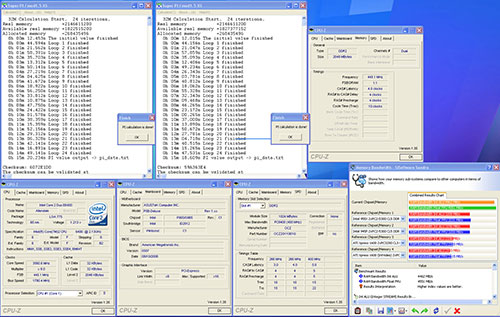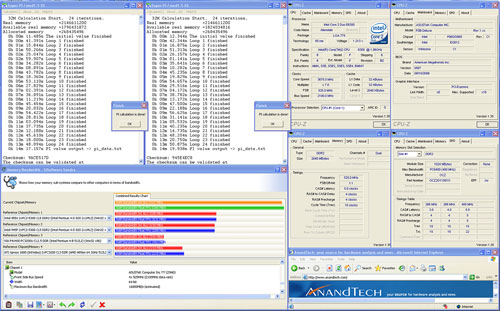ASUS P5B: New BIOS Adds Unlocking & Improved Overclocking
by Wesley Fink on August 24, 2006 3:00 PM EST- Posted in
- Motherboards
As more experience has been gained in overclocking Core 2 Duo chips, it is becoming clear that the 4MB cache E6700 and E6600 do not overclock quite as well as the 2MB Cache chips. There is not a huge difference in the overclocking of 2MB and 4MB at each multiplier, but there is a small advantage to the 2MB design for overclocking. Keep in mind, however, that 2MB performance is lower, so that tends to offset any advantage the 2MB E6400 and E6300 designs might enjoy.
E6400
The E6400 starts at 8x266 or 2.13GHz. With the new 507 BIOS we managed to reach stable speeds of 445x8, 511x7, and 514x6. This composite should give you a better idea of performance at a FSB of 445x8. There is a huge amount of capture information in this image, so you will need to click to enlarge it to readable size.
The jump from 2.13GHz to 3.58GHz is an amazing overclock of 1449MHz, or almost 1500 MHz. Percentage wise, this is a bit more than 68%. With the new ASUS BIOS, we now have the ability to do similar overclocks with the bus speed. With the 6400 the bus speed can now be adjusted from 266 to 514, which represent s a potential bus speed overclock of 93% - almost double the stock 266 FSB speed.
E6300
At $183 the E6300 represents the best value among the Core 2 Duo processors. The 65nm architecture combined with a low starting speed of 1.83GHz presents buyers with some amazing overclocking potential. These capabilities are enhanced further with the ASUS 0507 BIOS.
The E6300 unlocked down and reached 525x7 at stock multiplier. We were very near the limits of the ASUS P5B with the new BIOS and Scythe Infinity air cooling since dropping to x6 only gained us a few more MHz on the FSB, namely 532 at 6X. This is a100% bus overclock and it clearly demonstrates the added flexibility of the lower speed Core 2 Duo chips.
While the 2MB cache E6400 and E6300 reached higher bus speeds and CPU clocks than the 4MB E6700 and E6600, keep in perspective that the 4MB versions perform faster clock for clock. Any advantage the 2MB might have in our testing is small and is more than offset by the 4MB performance advantage. Still, the 2MB models are definitely impressive overclockers and they are both excellent values in the Core 2 Duo line-up.
E6400
The E6400 starts at 8x266 or 2.13GHz. With the new 507 BIOS we managed to reach stable speeds of 445x8, 511x7, and 514x6. This composite should give you a better idea of performance at a FSB of 445x8. There is a huge amount of capture information in this image, so you will need to click to enlarge it to readable size.
 |
| Click to enlarge |
The jump from 2.13GHz to 3.58GHz is an amazing overclock of 1449MHz, or almost 1500 MHz. Percentage wise, this is a bit more than 68%. With the new ASUS BIOS, we now have the ability to do similar overclocks with the bus speed. With the 6400 the bus speed can now be adjusted from 266 to 514, which represent s a potential bus speed overclock of 93% - almost double the stock 266 FSB speed.
E6300
At $183 the E6300 represents the best value among the Core 2 Duo processors. The 65nm architecture combined with a low starting speed of 1.83GHz presents buyers with some amazing overclocking potential. These capabilities are enhanced further with the ASUS 0507 BIOS.
 |
| Click to enlarge |
The E6300 unlocked down and reached 525x7 at stock multiplier. We were very near the limits of the ASUS P5B with the new BIOS and Scythe Infinity air cooling since dropping to x6 only gained us a few more MHz on the FSB, namely 532 at 6X. This is a100% bus overclock and it clearly demonstrates the added flexibility of the lower speed Core 2 Duo chips.
While the 2MB cache E6400 and E6300 reached higher bus speeds and CPU clocks than the 4MB E6700 and E6600, keep in perspective that the 4MB versions perform faster clock for clock. Any advantage the 2MB might have in our testing is small and is more than offset by the 4MB performance advantage. Still, the 2MB models are definitely impressive overclockers and they are both excellent values in the Core 2 Duo line-up.










84 Comments
View All Comments
Wesley Fink - Thursday, August 24, 2006 - link
We agree with you. We stated what we found - all Conroes we tested unlocked down. We also told you what Asus told us, but we were clear it could not be confirmed in our own testing. We did see screen shots of a locked Conroe at higher multipliers, but we did not find one in our testing. Our coverage was fair IMHO.Sunrise089 - Friday, August 25, 2006 - link
I would say the coverage was helpful, but not fair. Or if it was fair, it wasn't what I except from AT. I think normally you guys are pretty tough on campanies that don't deliver on promises, which is great because:-You're an advocate for the consumer
-You serve as a counterweight to huge manufacturer-funded marketing efforts.
I think your position on promised video-card launch dates that came and went was more what I like - you reported the manufacturer's stated date, but also blasted the GPU maker for letting the dates slip in the past and suggested it was likely to happen again.
It's fine to publish ASUS's claims, after all you want them to send you products to review, but why not editorialize a little more. Not have one chip that did what they claimed was sure plenty of justification.
Sapiens - Saturday, August 26, 2006 - link
So we should blame ASUS for the lack of Conroe chips at AnandTech that can be unlocked upwards? AT stated ASUS' claims and warned that they weren't able to verify all of them. It sounds like you just want the authors of the article to bash someone.Sunrise089 - Saturday, August 26, 2006 - link
I want the authors to keep up working on behalf of the consumer. When a company touts a feature that isn't present in many if not most cases, the company shouldn't get much credit for the "feature". Repeating the party line offered by ASUS gives them more credibility than they need to be given here. You and I can all go to ASUS's site and read up on their marketing department's list of reasons to buy their board, I expect AT to revivew the board with an eye to using their expertiese to inform me about it's strengths and weaknesses. An advertised feature that is present in ZERO percent of tested boards is more of a minus than a plus.